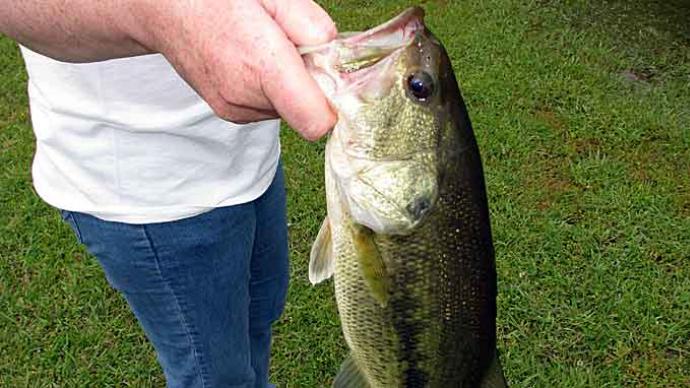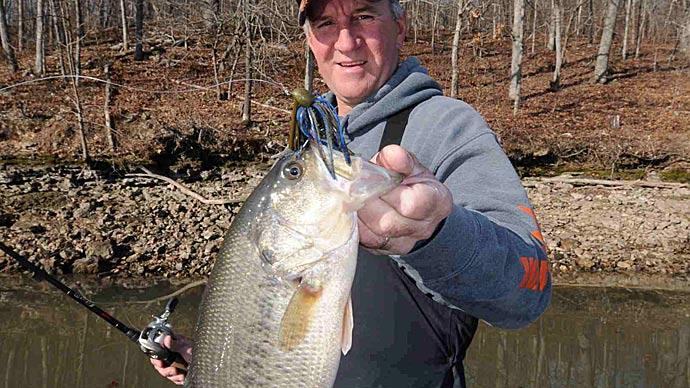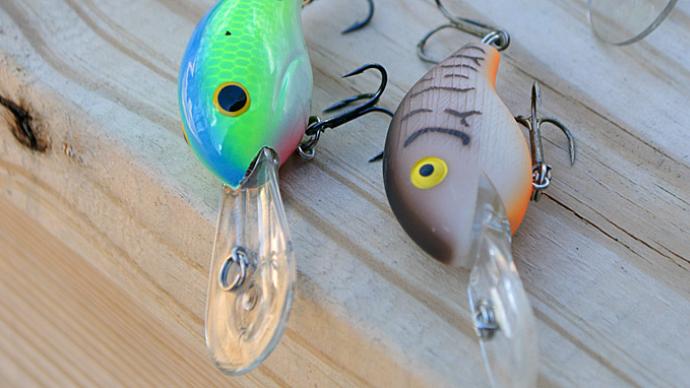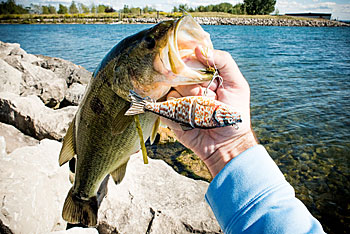
I was going fishing, whether I had a boat or not. The early summer weather was perfect. Lake Champlain was warm, and the bass had to be biting. From the parking lot, I hopped rock to rock, making my way along the riprap bank that protected the road from a shallow bay. I wanted to be at the other end, where the bridge took off over this small portion of the 125-mile-long lake that splits New York and Vermont.
The bridge’s closest pilings were a short cast away, and the wind pushed water past them, creating a current. It activated a few of the lake’s famous smallmouth, which couldn’t resist my jerkbait. After that bite slowed, I fished my way back to my truck, casting a small grub to logs and new patches of aquatic vegetation not far from the riprap. They produced a few largemouth to add to my tally.
The entire lake is yours when you’re in a boat. Crank the engine, and you can easily race off to the next stop, whether that’s a backwater, the main lake, or somewhere in between. Those moves are more difficult for bank-bound anglers. Their game is played within a cast of the shore. But that doesn’t mean they are stuck with whatever is available. By understanding bass behavior, lure selection, and where different depths, structure, and cover can be found, they can maximize their position and land more and bigger bass. Here are five ways to do just that.
Follow seasonal movements
Buffalo, N.Y.’s harbor welcomes Great Lakes ships and recreational boaters from Lake Erie. In the spring, it also hosts many of Erie’s giant smallmouth, searching for a protected place to spawn. Charles Waldorf stands on the bank, waiting for them.
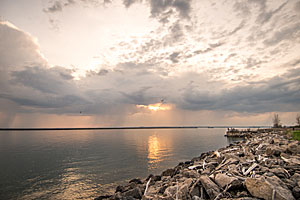
A professional photographer who shoots FLW Tour and Costa Series bass tournaments, Waldorf has spent plenty of time walking along and fishing from the banks around his hometown, from its harbor to Peace Bridge. He knows that soon after the ice disappears, prespawn smallmouths will be shallow and ready to bite his drop shot, tube jig, jerkbait, or spinnerbait. And they keep doing that until the water temperature rises, pushing them back into the lake. He focuses on the largemouth, which can be caught close to shore from the ice.
The first step toward catching more bass from the bank involves understanding and exploiting their seasonal movements. Like clockwork, bass move shallow in spring to spawn, deep in summer to chase baitfish, and then back shallow in fall. While weather and other environmental conditions, such as water temperature and level, dictate how fast they make these moves or their exact position at any given time, they always happen. Knowing them means you’ll be in the right spot at the right time.
Bass are most accessible to anglers when they are shallow in spring and fall. Search back of bays or the top end of reservoirs. Slow-moving feeder streams, where more often than not there’s a bridge you can fish near, are prime spawning spots. When bass follow baitfish offshore in summer, bank anglers must search for places to catch them.
Bridges are expensive to build, so they’re often placed where lakes and rivers are the narrowest. They also rely on manmade lead-ups, often covered with riprap, to shorten the span. If you have access to that section of shoreline, you can get closer to the main lake structure, where bass school during summer. That’s because the river or creek channel has to go under the bridge. The restriction often magnifies current, and there usually is a hard bottom — a bass favorite — because the water cannot wash that section wider.
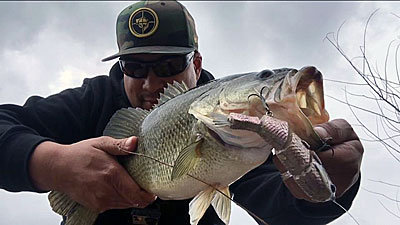
You won’t be able to throw a deep-diving crankbait. It will be too much work to fight it across a bottom that’s coming up while diving deeper. Sling a 1-ounce jig or Carolina rig, which saw a resurgence at the 2017 Bassmaster Classic on Lake Conroe in Texas. If the situation calls for a moving lure, try a 1-ounce spinnerbait outfitted with a lively trailer and one No. 4 or No. 5 willow-leaf blade. Cast it out, and let it sink to the bottom. Retrieve it fast enough, so it slowly rolls above the bottom and bangs off any cover or structure it comes across. And unlike a crankbait, a faster retrieve will bring it shallower, following the bottom contour back to where you are standing.
Gun and run
Bass anglers in boats like to be on the move. They are always on the trolling motor, moving from one piece of cover or section of the structure to the next, searching for bass willing to strike their lure. Covering water can often mean the difference between catching and going home skunked. It’s no different for bank anglers.
The smaller the body of water you’re fishing, the easier it is to move around. Ponds, for example, are typically accessible on all sides. Access is often segmented into larger lakes, rivers, and reservoirs. If there is a park or historic site on the body of water, search out waterfront trails. They will give you a quick and easy way to cover the ground. Just find your way to the water’s edge when you want to make a cast.
Wheels — the nickname given to outboard propellers — has a literal meaning for bank anglers such as Ray Quijano. He’s a member of Chicago’s CAST Crew, a group of anglers dedicated to the urban bass fishing lifestyle. His truck is his boat. Loaded with rods, tackle, and GPS, he drives from spot to spot. One recent weekend, he strung a bunch together while considering traffic to form a milk run. “I’d get out of the truck and make a few casts,” he said. If they didn’t bite at one, he got back behind the wheel and drove to the next. “I may come back [to a spot] later.”
Don’t shy away from public fishing access. State fisheries often construct piers and parking at them and seed the water with fish attractors. They draw fishing pressure, but that is because they draw fish.
Wait and see
All is not lost if you don’t have the ability or access to create a milk run. If you’ve caught bass from a particular spot in the past, chances are good that you’ll catch them there again.
First, it’s essential to locate the spot’s fundamental structure or cover that attracts and holds bass. The closer the spot is to the main lake, the more likely a school of bass will move onto it. For example, there are several options if it’s a cove with a few laydown trees. Fish them from as many angles as possible. Bang a fast-moving square-bill crankbait through the limbs, and then pick apart each with a worm, jig, or both.
Try fishing the spot at different times. Some places produce better in the morning than in the evening. Weather changes can make a spot better, too. If the wind blows onto it, baitfish will follow their microscopic food there, and bass won’t be far behind. And riprap banks warm up fast on sunny spring days, putting prespawn bass on the feed.
Change it up
Regardless of fishing one-stop or a series of places throughout an entire day, you’ll want to rotate through at least a couple of different lures at each. Bass get bored with the same offerings, so something different can ignite their inherent curiosity, causing them to strike.
Wholesale changes, such as picking up a Texas-rigged worm if you were throwing a spinnerbait, work, but you don’t always have to go to that extreme. Try a smaller version of the lure you were casting or one that’s a different color. Going bigger can be a good move, too. That lure will displace more water, creating a stir that can provoke a bass into striking.
There are other ways to change your lure’s look. Sometimes adding a rattle or changing the weight on your soft-plastic lure can make a difference. Also, try adding a touch of chartreuse or orange dye to the tail. That’s something that can be done to hard baits, too.
Try changing your retrieve speed. Letting your lure “soak” in one spot can provoke an inactive bass. Other times moving your lure faster will have the same effect.
Go finesse
Bank fishing is so prevalent in Europe that anglers are forced to use microscopic baits under floats the diameter of a twig to overcome fishing pressure. While conditions aren’t usually intense on stateside waters, U.S. bank anglers still deal with them. There are only so many places to fish, so that a finesse approach can coax more bites from pressured bass.
Instead of a quick sinking Texas rig, put your soft-plastic lure on a wacky or Neko rig, the latter being where weight is inserted into one end of the bait and a hook once through closer to the other. A drop shot works, even if you aren’t fishing vertically. Cast it out, and let the weight hit bottom. Then use the slack in your line to work the bait. Reel it ahead some, and repeat the process. Make sure your rod tip is high. That will create the required slack.
Finesse is more than a lure selection for bank anglers. It also includes switching to a lighter line, making quieter casts, and even kneeling on the bank to reduce your silhouette, which could spook bass.


